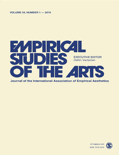
Empirical Studies of the Arts
Scope & Guideline
Elevating Arts Scholarship with High-Impact Research
Introduction
Aims and Scopes
- Interdisciplinary Research on Aesthetics:
The journal emphasizes interdisciplinary approaches, integrating psychology, sociology, and cultural studies to investigate how individuals perceive and engage with art. - Empirical Analysis of Artistic Experiences:
It focuses on empirical studies that assess the aesthetic experiences of individuals, examining factors such as emotion, cognition, and context in the appreciation of art. - Impact of Art on Well-Being:
A core area of research investigates how engagement with the arts contributes to mental health and well-being, exploring therapeutic applications of art across various contexts. - Cultural and Social Dynamics in Art:
The journal explores the socio-cultural dimensions of art, including how cultural background influences aesthetic preferences and the role of art in social change. - Technological Influence on Art Engagement:
It addresses the impact of technology, such as virtual reality and digital platforms, on artistic experiences, examining how these innovations shape audience interaction with art.
Trending and Emerging
- Mental Health and Art Therapy:
A growing trend highlights the intersection of art and mental health, with numerous studies exploring how creative practices can enhance psychological well-being and serve as therapeutic interventions. - Digital and Virtual Art Experiences:
There is an increasing focus on how digital platforms and virtual reality are transforming art engagement, with research examining user experiences and the emotional impacts of these technologies. - Cross-Cultural Aesthetic Preferences:
Emerging studies are examining cross-cultural differences in aesthetic preferences, reflecting a broader interest in globalization and the diverse ways art is perceived across cultures. - Interdisciplinary Approaches to Art Education:
A trend towards interdisciplinary methods in art education is evident, with research evaluating innovative teaching strategies that incorporate technology and collaborative learning. - Emotional and Cognitive Responses to Art:
There is a significant rise in studies investigating the emotional and cognitive processes involved in art appreciation, including how individual differences affect aesthetic experiences.
Declining or Waning
- Traditional Art Forms and Historical Analysis:
Research focusing on traditional art forms and historical analyses has decreased, indicating a shift towards contemporary practices and empirical methodologies in understanding art. - Purely Theoretical Discussions of Aesthetics:
There has been a noticeable decline in purely theoretical discussions without empirical backing, as the journal increasingly favors studies that incorporate data and quantitative analysis. - Art Market Dynamics and Economic Analysis:
While the art market remains an important area, the frequency of studies specifically analyzing economic factors within the art market has diminished, suggesting a move towards more experiential and psychological aspects of art.
Similar Journals

CREATIVITY RESEARCH JOURNAL
Advancing Understanding in Creative DisciplinesCREATIVITY RESEARCH JOURNAL, published by Routledge Journals, Taylor & Francis Ltd, is a pivotal platform in the fields of developmental and educational psychology, visual arts, and performing arts. With a notable impact factor and classification in Q2 for developmental and educational psychology and miscellaneous psychology, and Q1 for visual and performing arts, this journal stands out for its rigorous peer-reviewed articles that foster a deeper understanding of creativity and its multifaceted dimensions. Since its inception in 1988, the journal has significantly contributed to the discourse surrounding creativity, providing valuable insights and research findings that benefit researchers, educators, and practitioners alike. Although it does not operate under an open access model, it remains a highly regarded resource, indexed in Scopus with commendable ranks in various categories, reflecting its influence and relevance in contemporary academic conversation. By bridging gaps between theory and practice, the CREATIVITY RESEARCH JOURNAL aims to inspire innovative thinking in both academic and applied settings, making it essential reading for anyone interested in the dynamic landscape of creativity studies.

Quintana-Revista do Departamento de Historia da Arte
Illuminating the Intersection of Art History and Cultural HeritageQuintana-Revista do Departamento de Historia da Arte, published by the Universidade de Santiago de Compostela, is a distinguished academic journal that focuses on the critical analysis and exploration of visual arts and performing arts. With its ISSN 1579-7414 and E-ISSN 2340-0005, this journal serves as a vital platform for researchers, professionals, and students interested in the depth of art history and cultural discourse. Operating under a Q4 category in the realm of Visual Arts and Performing Arts, the journal is committed to fostering scholarly dialogue and advancing knowledge in the field. Though it currently does not offer open access options, it remains an invaluable resource for those aiming to contribute to and understand the evolving landscape of art history. The journal covers converged years from 2011 to 2012 and 2014 to 2024, highlighting its ongoing relevance and adaptability to contemporary discussions. As it continues to enhance its visibility and impact within the 20th percentile of its category according to Scopus rankings, Quintana invites contributions that deepen our understanding of artistic expression and cultural heritage.

Taida Journal of Art History
Illuminating the intersections of culture and creativity.Taida Journal of Art History, published by NATIONAL TAIWAN UNIVERSITY, GRADUATE INSTITUTE OF ART, is a pioneering academic journal dedicated to the exploration and critique of art history, particularly within the unique cultural context of Taiwan. Since its inception in 2018, the journal has become an important platform for scholarly discourse, offering insights into the evolution of visual arts and performing arts, alongside comprehensive studies in history. With an ISSN of 1023-2095, it currently ranks within the Q4 category in Arts and Humanities (Miscellaneous) and the Q3 category in History and Visual Arts and Performing Arts, indicating its growing influence in these fields. Researchers, professionals, and students alike can benefit from its rigorous peer-reviewed articles that bridge theoretical frameworks with practical applications, making it an essential resource for those engaged in the arts and humanities. This commitment to fostering academic excellence is reflected in its Scopus rankings, where it stands at Rank #338/667 in Visual Arts and Performing Arts and Rank #1027/1760 in History. Engage with the Taida Journal of Art History to gain deeper insights into the evolving narratives of artistic expression.
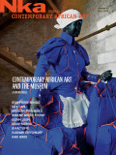
Nka-Journal of Contemporary African Art
Fostering Inclusivity in the Visual Arts LandscapeNka-Journal of Contemporary African Art is a premier academic publication dedicated to exploring the rich tapestry of contemporary African art and its intersections with culture, society, and identity. Published by DUKE UNIVERSITY PRESS, this journal offers a platform for critical discourse and innovative research within the fields of Visual Arts and Anthropology, earning a commendable ranking in both categories, with a Q2 designation in Visual Arts and Performing Arts. Established in 2019, Nka serves to illuminate the dynamic and evolving narratives of African artists, providing a vital connection for scholars and practitioners engaged with African cultural production. Although currently not open access, the journal aims to foster intellectual engagement and promote inclusivity in the arts, making it an essential resource for those seeking to deepen their understanding of contemporary African artistic practices. With an address based in the heart of Durham, North Carolina, Nka invites contributions from a diverse range of voices to enrich the discourse surrounding contemporary African art.

Boletin de Arte-UMA
Illuminating the Intersections of Art and HistoryBoletin de Arte-UMA is a distinguished academic journal published by the University of Malaga, Department of History of Art, focusing on the rich interplay between history, visual arts, and performing arts. Operating under an Open Access model since 2013, this journal ensures that valuable research is freely available for scholars and practitioners worldwide. With an impact factor currently reflecting its academic rigor through its Q2 ranking in History and Q1 ranking in Visual Arts and Performing Arts, Boletin de Arte-UMA serves as a vital platform for cutting-edge research, critical analysis, and the promotion of cultural heritage studies. Based in Malaga, Spain, the journal not only provides insights into its thematic scope but also fosters a global dialogue among researchers, professionals, and students passionate about the visual and performing arts.
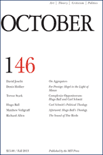
OCTOBER
Navigating the Rich Tapestry of Artistic ExpressionOCTOBER is a seminal journal published by MIT PRESS that spans a diverse array of interdisciplinary themes within the humanities, specifically focusing on literature and literary theory, music, and the visual arts and performing arts. Established in 2002, this journal has become a cornerstone for scholars and practitioners seeking critical discourse and innovative research across its converged fields, maintaining a respectable impact factor that attests to its influence in academic circles. While OCTOBER currently does not offer open access, it provides valuable insights and analysis that drive contemporary thought and discussion, positioned in the Q2 and Q3 quartiles of Scopus rankings. The journal’s commitment to high-quality scholarship makes it an essential resource for those looking to deepen their understanding of cultural and artistic practices, reflecting the evolving landscape of the arts and humanities from a rigorously theoretical perspective.

De Medio Aevo
Championing Academic Excellence in Cultural Studies and BeyondDe Medio Aevo is a distinguished academic journal published by UNIV COMPLUTENSE MADRID, SERVICIO PUBLICACIONES, dedicated to enriching the fields of Cultural Studies, History, Literature and Literary Theory, Philosophy, Religious Studies, and Visual Arts and Performing Arts. Since its inception in 2012 as an Open Access platform, this Spanish journal has rapidly established its reputation, achieving impressive rankings in various categories with a Q1 classification in Literature and Literary Theory and notable positions in Q2 across other fields as per the 2023 metrics. With an emphasis on rigorous scholarly research, De Medio Aevo seeks to foster the exchange of ideas and insights that reflect the rich tapestry of medieval studies and its ongoing impact on contemporary society. It is an essential resource for researchers, professionals, and students alike, encouraging interdisciplinary dialogue and exploration of the cultural narratives that shape our understanding of history and the arts. Located in Madrid, Spain, the journal is committed to making significant contributions to its fields, with a global reach and a focus on academic excellence.

SituArte
Illuminating Visual Culture Through Scholarly InsightSituArte is an esteemed academic journal published by UNIV ZULIA-VENEZUELA, focusing on the interdisciplinary fields of art, culture, and social sciences, particularly within the Latin American context. With its ISSN 1856-7134 and E-ISSN 2542-3231, SituArte endeavors to foster critical discourse and promote innovative research that explores the dynamic interplay between visual culture and societal impacts. Although this journal does not currently offer open access options, it remains a vital resource for researchers, professionals, and students seeking to contribute to the evolving conversations in these disciplines. Situated in Maracaibo, Venezuela, SituArte emphasizes regional perspectives while engaging with global trends, making it an essential platform for disseminating scholarly work that challenges conventional paradigms and enriches the academic community.
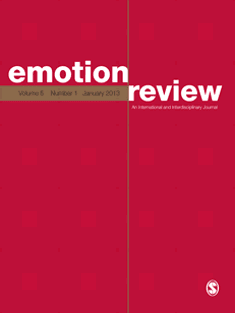
Emotion Review
Connecting Disciplines Through Emotional InsightEmotion Review, published by SAGE Publications Inc, is a leading international journal that focuses on the multidisciplinary examination of emotional processes across various fields. Launched in 2009 and maintaining a strong presence in the UK, this journal has rapidly ascended to be classified in the Q1 quartile across several categories, including Arts and Humanities (miscellaneous), Experimental and Cognitive Psychology, and Social Psychology. With its outstanding Scopus rankings—evident from its 93rd percentile in Arts and Humanities and 88th percentile in Psychological disciplines—Emotion Review plays a crucial role in advancing the understanding of emotional phenomena, offering a platform for innovative research and theoretical developments. While this journal does not provide open access options, it remains a vital resource for researchers, professionals, and students eager to explore the complexities of emotions and their impact on human behavior, making it an essential addition to any academic library.
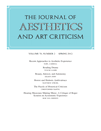
JOURNAL OF AESTHETICS AND ART CRITICISM
Connecting Minds Through Art and PhilosophyThe Journal of Aesthetics and Art Criticism, published by Oxford University Press, stands as a premier platform for scholarly discourse in the realms of music, philosophy, and the visual and performing arts. Established in 1996 and continuing through 2024, this journal has achieved remarkable recognition, being ranked in the Q1 category across several disciplines, and securing prestigious positions in various Scopus rankings: 29th in Music, 50th in Visual Arts and Performing Arts, and 151st in Philosophy, showcasing its essential contribution to arts and humanities scholarship. While not an open-access journal, its rich repository of articles offers invaluable insights for researchers, professionals, and students alike, fostering a deeper understanding of aesthetics and critical theory. The journal's commitment to interdisciplinary approaches opens pathways for innovative dialogue, making it an indispensable resource for anyone engaged in the study and appreciation of the arts.